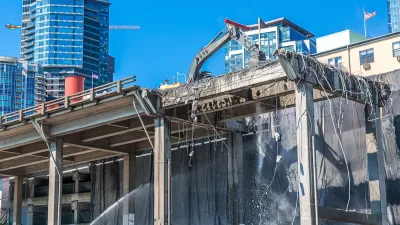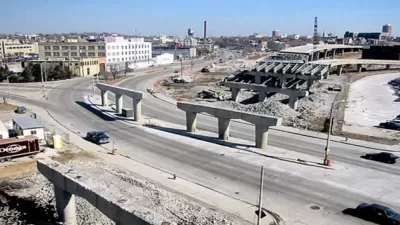In Michigan, the state's Department of Transportation is looking for ways to mitigate the damage caused by decades of urban renewal policies and reconnect neighborhoods cut off from amenities and opportunities by highway projects.

In response to criticism of the Biden administration's commitment to addressing the racism and discrimination built into U.S. roads, Nancy Derringer explains how roads and infrastructure can have disproportionately negative impacts on Black and brown communities, quoting Paul Ajegba, director of the Michigan Department of Transportation, who participated in a recent virtual panel on the issue. As Derringer writes,
Southeast Michigan is dotted with examples of roads and infrastructure that had the effect of dividing or demolishing neighborhoods populated by people of color. I-375, the spur that carries motorists from I-75 into downtown, is only the most obvious example. Built from 1959-65, it sliced through the footprint of the Black Bottom neighborhood, which had already been razed in the name of urban renewal. The generational wealth that was lost is incalculable, Ajegba said.
"Rather than top-down planning and development, today’s infrastructure design is more likely to be a collaborative effort that looks at nearby neighborhoods holistically, said Jon Kramer, another panelist and president of OHM Advisors, consultants who aid in such planning."
Planners are also recognizing the importance of multimodal transportation options and the need to replace car-centric infrastructure with safe, convenient facilities that benefit pedestrians, cyclists, and transit riders as well. Ajegba states that policymakers in Michigan have "a renewed emphasis on equity, inclusion and social justice."
FULL STORY: How can a road be racist? Don't ask that question in Michigan.

Alabama: Trump Terminates Settlements for Black Communities Harmed By Raw Sewage
Trump deemed the landmark civil rights agreement “illegal DEI and environmental justice policy.”

Study: Maui’s Plan to Convert Vacation Rentals to Long-Term Housing Could Cause Nearly $1 Billion Economic Loss
The plan would reduce visitor accommodation by 25% resulting in 1,900 jobs lost.

Planetizen Federal Action Tracker
A weekly monitor of how Trump’s orders and actions are impacting planners and planning in America.

Waymo Gets Permission to Map SF’s Market Street
If allowed to operate on the traffic-restricted street, Waymo’s autonomous taxis would have a leg up over ride-hailing competitors — and counter the city’s efforts to grow bike and pedestrian on the thoroughfare.

Parklet Symposium Highlights the Success of Shared Spaces
Parklets got a boost during the Covid-19 pandemic, when the concept was translated to outdoor dining programs that offered restaurants a lifeline during the shutdown.

Federal Homelessness Agency Places Entire Staff on Leave
The U.S. Interagency Council on Homelessness is the only federal agency dedicated to preventing and ending homelessness.
Urban Design for Planners 1: Software Tools
This six-course series explores essential urban design concepts using open source software and equips planners with the tools they need to participate fully in the urban design process.
Planning for Universal Design
Learn the tools for implementing Universal Design in planning regulations.
Caltrans
Smith Gee Studio
Institute for Housing and Urban Development Studies (IHS)
City of Grandview
Harvard GSD Executive Education
Toledo-Lucas County Plan Commissions
Salt Lake City
NYU Wagner Graduate School of Public Service





























